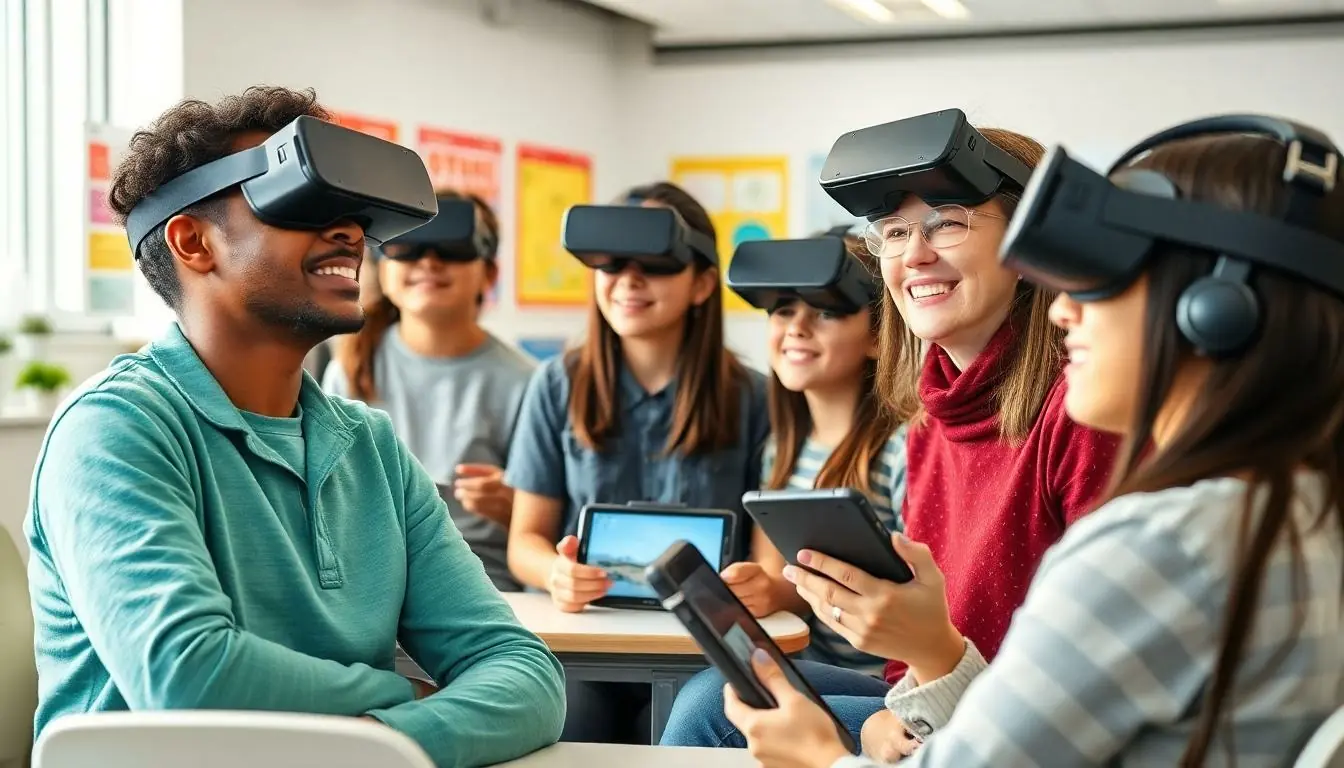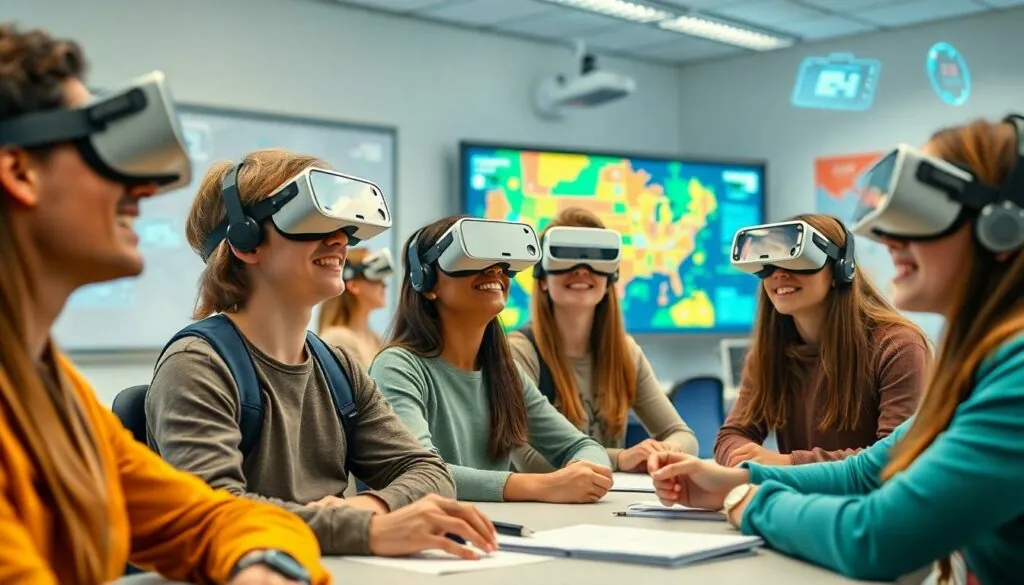Table of Contents
ToggleIn a world where textbooks are practically ancient relics, education technology is stepping in like a superhero in a cape. High-end innovations are transforming classrooms into futuristic learning hubs, making education not just effective but downright exciting. Imagine students engaging with holograms instead of dusty old pages or using virtual reality to explore the depths of the ocean without ever getting their feet wet.
Overview of High-End Innovations in Education Tech
Advanced technologies shape modern education, driving significant changes in how students learn. Devices such as interactive whiteboards facilitate real-time collaboration among peers and educators. Smart classrooms utilize Internet of Things (IoT) devices to create customized learning experiences based on each student’s unique needs.
Augmented reality (AR) engages students by blending digital information with the physical world. Users can explore complex concepts through immersive simulations that deepen understanding and retention. Institutions also implement artificial intelligence (AI) to personalize learning pathways, ensuring targeted content delivery tailored to each learner’s pace and style.
Learning management systems (LMS) support educators in administering materials, tracking student progress, and managing assessments efficiently. Cloud-based platforms enable easy access to resources, fostering collaboration beyond the classroom’s physical boundaries.
Adaptive learning technologies respond to student performance in real time, making adjustments that enhance the effectiveness of instruction. Gamification elements make learning more enjoyable, motivating learners through challenges and rewards.
High-end innovations in education tech create an engaging, dynamic environment where students benefit from interactive learning experiences. They augment traditional methods, making education more effective and accessible than ever before. This shift not only enhances student engagement but also prepares them for a technology-driven future, opening doors to new possibilities in their educational journeys.
Emerging Technologies in the Classroom

Emerging technologies are reshaping classroom experiences, enhancing both teaching and learning methods.
Virtual Reality and Augmented Reality
Virtual reality (VR) allows students to immerse themselves in simulated environments, fostering hands-on learning without leaving the classroom. Augmented reality (AR) supplements real-world environments with interactive digital elements, bringing complex subjects to life. By using VR headsets and AR applications, learners can explore ancient civilizations or conduct virtual science experiments. These technologies cater to various learning styles, thus improving comprehension and retention. Teachers can leverage VR and AR to create engaging lessons that capture student interest. Research indicates that using AR and VR in education boosts motivation and engagement, leading to improved academic performance.
Artificial Intelligence in Education
Artificial intelligence (AI) personalizes learning experiences, allowing students to progress at their own pace. AI-driven platforms create customized pathways based on individual performance, addressing unique learning needs. Such technologies analyze data, gaining insights into student behavior and engagement levels. Moreover, AI chatbots provide instant feedback and support, enhancing communication between students and educators. Adaptive learning systems utilize AI to shift instructional strategies when necessary, ensuring concepts align with student understanding. Schools that integrate AI report increased efficiency in administrative tasks and improved student outcomes, making AI an essential component in the future of education.
Enhancing Learning Experiences
Advanced technologies create more engaging and effective learning environments. They enhance student interaction, boost motivation, and personalize education.
Adaptive Learning Platforms
Adaptive learning platforms utilize artificial intelligence to tailor educational experiences. These platforms analyze individual student performance and modify content to meet unique needs. For example, platforms like DreamBox and Smart Sparrow adjust lessons in real-time, ensuring students grasp concepts before advancing. Schools using adaptive learning report increased retention rates and improved test scores. Custom pathways lead to a more personalized and effective learning journey, empowering students to learn at their own pace.
Gamification of Education
Gamification transforms traditional educational methods into dynamic learning experiences. By incorporating game-like elements, educators engage students more effectively. Tools like Kahoot and Classcraft introduce competition, challenges, and rewards, motivating students to participate actively. Research shows that gamified learning enhances focus and boosts memory retention. Additionally, these strategies create a fun atmosphere that encourages collaboration and teamwork among peers. Integrating gamification into classrooms not only promotes engagement but also fosters essential skills for the future.
Improving Administrative Efficiency
High-end innovations in education technology streamline administrative tasks, boosting efficiency and allowing educators to focus on teaching.
Learning Management Systems (LMS)
Learning Management Systems, or LMS platforms, simplify course administration and facilitate communication between teachers and students. Popular LMS options like Canvas and Blackboard provide centralized access to resources, grades, and feedback. These systems automate tasks, reducing the time spent on administrative duties. Instructors can track student progress and adapt lesson plans accordingly, addressing individual learning paces. As a result, students benefit from easier access to materials and clearer communication, enhancing the overall educational experience.
Data Analytics in Education
Data analytics in education plays a crucial role in enhancing decision-making and improving outcomes. Platforms leverage data to identify student trends, pinpoint areas for growth, and optimize resource allocation. Schools utilizing analytics tools, such as Power BI or Tableau, gain insights into academic performance and engagement metrics. By analyzing attendance records and assessment scores, educators can implement targeted interventions for at-risk students. Transformations in administrative processes stem from harnessing data effectively, driving improved student success and operational efficiency through informed strategies.
Future Trends in Education Technology
Emerging technologies continue to redefine educational landscapes. Virtual reality and augmented reality transform learning experiences, immersing students in interactive environments. AI-driven platforms not only personalize learning but also analyze data to enhance educational outcomes. Chatbots facilitate communication, making it easier for students to connect with educators about academic challenges.
Adaptive learning platforms adjust in real-time based on individual student performance. DreamBox and Smart Sparrow exemplify tools that increase retention and improve test scores through customized lesson adjustments. Gamification elements in tools like Kahoot and Classcraft motivate students, driving engagement and promoting collaboration.
Data analytics plays a crucial role in informing educational strategies. Schools leveraging analytics tools can identify trends that enable targeted interventions for at-risk students. Learning management systems streamline course administration, enhancing the communication between instructors and students.
Internet of Things devices contribute to smart classrooms. These technologies foster personalized learning experiences that adapt to student needs and preferences. Interactive whiteboards support real-time collaboration, making lessons more engaging.
Enhanced technological integration in education prepares students for a digital future. Engagement rates soar when institutions embrace these innovations. Collectively, these advancements foster a dynamic learning environment, empowering students to excel academically and develop vital skills essential for success.
High-end innovations in education technology are revolutionizing the learning landscape. By incorporating tools like virtual reality and artificial intelligence, educators can create immersive and personalized learning experiences that cater to individual student needs. These advancements not only enhance engagement but also prepare students for a technology-driven future.
As educational institutions continue to adopt these cutting-edge technologies, the potential for improved academic outcomes and streamlined administrative processes becomes increasingly evident. The dynamic integration of these tools fosters a collaborative environment where both students and teachers thrive. Embracing these innovations will undoubtedly shape the future of education, empowering learners to excel in an ever-evolving world.







